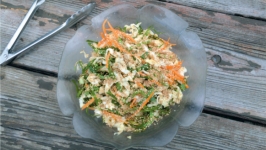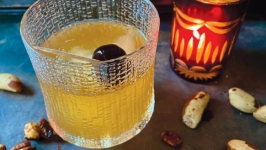Snout to Table
THE CHALLENGE
One dark winter night, I announced to my friends that I needed pork skin—raw, unprocessed skin from a compassionately raised pig to make traditional soup dumplings. Unexpectedly, I discovered that they also shared this desire for pork from a pig that lived well; they wanted healthy, flavorsome meat with a lowered carbon footprint that supports local farmers. The most economical way to do this was to form a meat share, which meant we’d purchase and process a whole pig ourselves. The catch? None of us had ever butchered a pig before. We decided to challenge ourselves by learning how. Pork aficionado and home chef Kimbo Maher immediately connected us to her friend who raises pigs. Hunter friend Dana Fjare valiantly offered to dispatch the pig. Her husband Dashiell Feierabend kindly agreed to help with the butchering. And I found myself at the leading edge of a snout-to-table Alaska saga.
THE FARM
Spring brings a multicolored piglet posse to Moose Creek Farm near Fairbanks. The farm raises pigs for customers who then take their purchased animal to a USDA-certified processor or do the slaughtering and butchering on their own. I arrive at the farm in early summer to meet the farmers and greet the pigs.
Most of the 80-acre farm includes a wide expanse of grassy pasture framed by birch trees. Here, Missy and Dan Rees maintain a large U-pick vegetable and berry garden in addition to a menagerie of horses, pigs, cows, rabbits, chickens, and bees. The animals forage on grass, weeds, and vegetable scraps in addition to a non-genetically modified mixture of barley and field pea from nearby Delta Junction.
As Missy walks into a fenced-in area, a group of pigs runs up to her. One chocolate colored piglet with translucent ginger hair sparkles in the sunshine. A spunky pink one with black splotches insistently bumps her leg. “I usually have pig goo all over my leg,” she says with a laugh. As she reaches down with outstretched arms, the pig flops onto one side for an enthusiastic belly rub. “I like them to live like this, enjoying the outside, digging for worms and grubs,” she says. “All summer they get to live with me, and I talk to them and touch them and love them.”
Although she gets attached to the animals, she knows that the subzero winter temperatures of interior Alaska would make them miserable. “We sell everybody as meat shares, nobody stays in the winter,” she says. “Everybody’s in the freezer.” Knowing Missy’s dedication and commitment for her pigs to live a good life leaves me with an even deeper sense of responsibility to ensure that everything goes smoothly on our pig’s last day.
THE TEACHERS
Despite our team’s current animal processing repertoire of medium-sized ruminants, birds, bunnies, and fish, signing up for a whole pig presents an intimidating challenge because of the hog’s size and anatomy. To add to the complexity, honoring the life of the animal requires figuring out how to avoid food waste and use every part of it. Cultures all over the world are experts at using the whole pig. Intestines provide sausage casings. The trotters and skin produce aspic. The head alone yields pounds of usable meat. Recipes for head cheese, terrine, and scrapple abound. How do I learn it all?
Between summer and fall, I read books and watched videos and tutorials online. I contacted farmer friends around Alaska for hands-on experience in the various steps of slaughter and butchery. As people who care deeply for the well-being of their animals, they are practical folks who desire for swift endings that minimize suffering. Their values aligned with my own, and I sought their teachings to inform my education and actions.
Brilliant fall colors already adorned the forest when I attended a pig butchering basics workshop with hunting guide Justin Cox at Calypso Farm in Fairbanks. There, I accompanied the farm’s apprentices in butchering a few of the pigs.
Next, I returned to Chugach Farm in Chickaloon where I joined Allie Barker, Jed Workman, and their friends to dispatch and process their four pigs from start to finish. The first day, autumn leaves swirled around us as we skinned, gutted, and cleaned the pigs. The next day, snow covered the ground as we completed the butchering, grinding, and packaging. I left Chugach Farm with an even greater admiration for my friends who provided an opportunity to create community around honest food, hard work, and sharing knowledge of skills for self-reliance.
The date for our own pig processing drew inevitably near. We needed to process our pig before winter set in. In a panic, I called Emily Garrity at Twitter Creek Gardens in Homer for hair scraping advice. Days before the pig date, I dropped by Rough Cut Farm to help Justin Maple and his friends dispatch a pig destined for charcuterie. As we scraped the stubborn bristles off the skin, I carefully listened to my pig professors to absorb their helpful tips from years of raising, processing, and eating pigs.
THE HUNTER, THE WRITER, AND THE PIG
Pig day arrives for me and my group of intrepid friends. We are alone with what we know, the tools we have, and our ability to do our best with what is to come.
Golden mist glimmers over the frozen field. The pale October sun illuminates Dana as she walks toward the animal. Our pig now weighs over 250 pounds. Head down, she eats. The only sound is breathing and chewing. Dana unslings the rifle from her shoulder, takes aim, and unlocks the safety. The air is still. One shot rings out. Echoes reverberate around the valley. The pig falls to the ground and she is instantly gone, though her body continues to thrash for several minutes as nerves release their final impulses. We stand in silence to honor and give thanks for her life. This is the most sobering and humbling part of eating animals and vegetables. Energies from the elements recombine and reconfigure as one life ends to feed another.
DEHAIRING
We cut the jugular vein and set the pig on a folding table. Nearby, water simmers on a propane stove. Recreating the scene at Rough Cut Farm, we ladle scalding water onto towel-covered sections of the pig. In the waning glow of civil twilight, the temperature dips below freezing and the water loses warmth faster than we can heat it. We scrape the pig’s long, coarse hairs with a borrowed bell hog scraper and small knives. Our toes freeze and our breath forms clouds in the chilly evening air. We make mental notes to save the bristles for brushes and to butcher in warmer weather next year.
After dehairing comes gutting. We carefully maneuver steaming entrails out of the body cavity and into a waiting wheelbarrow. The head, organs, and sections of the intestines go into separate buckets. I brace the pig while Dana uses a small saw to split the animal in half. We rinse and place the halves into game bags to cool overnight.
BUTCHERING
In the morning, tables sag noticeably under the weight of the hefty halves. Dash, Kimbo, and I form the butchering crew. While butchery is a profession that involves years of mastering different styles and specialized cuts, our novice decisions are guided by the pork dishes of our culinary dreams. Some bones stay in the meat while other bones are cut out for broth and soup. It takes all day to deconstruct the massive pig into ribs, roasts, hams, and bacon. Our conversation involves catching up on all matter of life events, or stories related to butchering and food. And sometimes our words fall away to silence as we concentrate on the tasks at hand. Only meat trimmings and fat remain to be ground up the next day. I save sheets of skin for a future kitchen saga.
After more than half a year of planning, researching, observing, apprenticing, and finally doing, our group of four friends parts ways with piles of neatly wrapped and labeled meat packages, ready for a deep sleep in the freezer.
GIVING THANKS
Each flavorful pork dish or spoonful of lard evokes memories and sentiments from the snout-to-table saga. I relive Missy’s joy, beaming and rubbing the bellies of happy piglets. I hear the voices of my encouraging farmer-mentors who inspire my confidence to follow in their footsteps. I witness the calm focus of Dana’s eyes as she decisively transforms an ending into a new beginning. I feel both reverence and sadness for the pig’s ultimate sacrifice. I appreciate Dash and Kimbo’s unshakable commitment to show up with sharp knives, strong backs, and good humor to lighten the load of butchering. Above all, my heart overflows with gratitude for nourishment that feeds the body, the mind, the soul, and the spirit of community.















